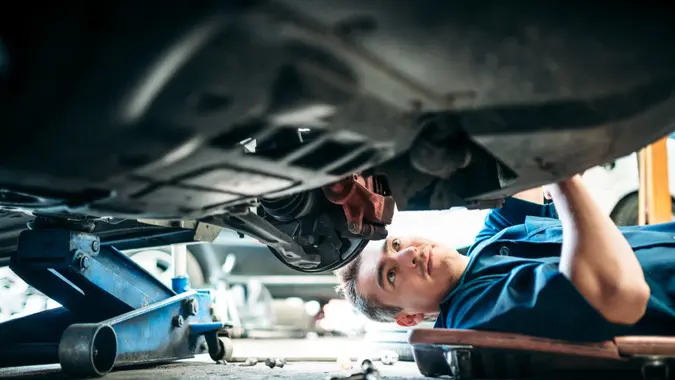
ferrantraite / Getty Images
With fall just around the corner, now is the perfect time to get your car in tip-top shape for the cooler, stormy months ahead. Taking steps to ensure your car is prepared for the season is crucial to not only ensure your safety but also to save money in both the short and long term.
Who better to share car tips than the vehicle experts themselves? Check out these eight car maintenance tips for the fall season that will help you prepare for the challenges that come alongside colder weather and wet and icy roads.
Check Tire Pressure
Fall’s wet and icy roads can be very dangerous for tires that aren’t adequately inflated.
“With temperatures dropping, tire pressure tends to decrease,” said John Lin, owner and prime mechanic at JB Motor Works in Philadelphia. “Underinflated tires can lead to unnecessary tire wear or even a flat in extreme cases. Checking and maintaining the right tire pressure not only saves you from expensive tire replacements but also improves your fuel efficiency.”
Replace Windshield Wiper Blades
It’s also crucial to inspect your windshield wiper blades for any signs of wear, including cracks or missing pieces, to help maintain visibility during rainy fall drives.
“Fall means more rainfall,” Lin said. “Worn-out wipers can impair your visibility, leading to accidents. Replacing them beforehand will save you from potential damage costs. It’s a relatively inexpensive and easy task that can save in the long run.”
Check Your Battery
A weak battery can leave you stranded, something you’ll want to avoid as the weather gets colder and the roads more treacherous.
“Cold weather can be hard on your car battery,” Lin said. “Before the peak of the fall, get your battery checked for any signs of wear or damage and if need be, consider replacing it. This will prevent unexpected breakdowns and save you costly emergency service fees.”
Inspect Engine Fluids
With the fall bringing fluctuating temperatures, it’s important to get your engine checked out to prevent it from freezing or overheating in varying weather conditions.
“It is important to check all the car’s vital engine fluids, such as transmission, coolants, braking and steering, on a regular basis, particularly prior to the start of winter,” said Pete Baldine, founder of Mr. Transmission. “Engines are also forced to work harder during the winter months, which can cause transmission and brake fluids to degrade. The most critical is replacing the engine’s oil every 3,000 miles. Regular oil changes are considered the most important thing anyone can do to maintain the life of their vehicle.”
Monitor Brake Health
Inconsistent brakes are the last thing you need when the frost hits. Because fall rains can make roads slick, it’s important to inspect brake pads and rotors for wear to ensure efficient braking and avoid costly repairs down the road.
“Brakes are exposed to snow and salt in the winter, so the fall is a good time to plan ahead and monitor their condition for the overall safety of the vehicle,” Baldine said. “Brake performance is especially important in winter, when roads are exposed to snow, sleet and ice. Any warning signs, such as screeching, pulling to one side or vibrations, are indications to take the car for a service inspection as soon as possible.”
Inspect Lights and Signals
Fall’s shorter days and longer nights mean you’ll be relying on your car’s lighting more. Ensure all lights, including headlights, tail lights and turn signals, are working correctly. Replacing any dead bulbs will help keep you and the cars around you safe on the road while avoiding getting a steep ticket for something that’s easy to fix.
Replace Air Filters
Over the summer, your car’s air filters have probably caught a lot of dust, pollen and road debris. A clogged air filter can lead to decreased fuel efficiency, and by replacing your air filter, you’ll ensure optimal fuel efficiency, saving money at the pump.
“A car’s air filter should be changed each year or every 15,000 miles,” Baldine said. “This gives the vehicle a good supply of clean air and prevents poor fuel economy and performance. A convenient time to have the filter checked or replaced is during oil change appointments.”
Clean and Wax the Vehicle
While it might seem silly and aesthetic, giving your car a fall makeover can have some significant positive effects. By giving your vehicle a thorough clean and wax just before the onset of fall, materials like leaves and residues stick to your car less, reducing the likelihood of scratches or damage to your paintwork — ultimately preserving your vehicle’s resale value.
More From GOBankingRates
